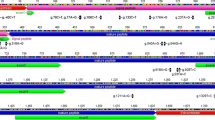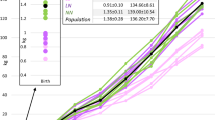Abstract
Inositol polyphosphate-5-phosphatase F (INPP5F) is one of the largest families of phosphoinositide phosphatases, 5-phosphatase. It contains a Sac domain whose amino acids are essential for inositol polyphosphate phosphatase activities. Here, we assigned the porcine INPP5F to SSC14q29 by using SCHP and IMpRH. Sequencing of PCR products from different breeds identified an A/G polymorphism in the last exon. The allele frequencies of this SNP showed that the Yorkshire and Duroc pigs have high G allele frequency, whereas the local pigs have high A allele frequency. Association analysis of the genotypes with growth and carcass traits found that different genotypes of INPP5F have significant differences in average daily gain (ADG) (P < 0.05) in Yorkshire pigs.

Similar content being viewed by others
References
Minagawa T, Ijuin T, Mochizuki Y et al (2001) Identification and characterization of a sac domain-containing phosphoinositide 5-phosphatase. J Biol Chem 276(25):2011–2015. doi:10.1074/jbc.M101579200
Ross TS, Jefferson AB, Mitchell CA et al (1991) Cloning and expression of human 75-kDa inositol polyphosphate-5-phosphatase. J Biol Chem 266(30):20283–20289
Mitchell CA, Gurung R, Kong AM et al (2002) Inositol polyphosphate 5-phosphatases: lipid phosphatases with flair. IUBMB Life 53(1):25–36. doi:10.1080/15216540210815
Storey DJ, Shears SB, Kirk CJ et al (1984) Stepwise enzymatic dephosphorylation of inositol 1,4,5-trisphosphate to inositol in liver. Nature 312(5992):374–376. doi:10.1038/312374a0
Proven A, Roderick HL, Conway SJ et al (2006) Inositol 1,4,5-trisphosphate supports the arrhythmogenic action of endothelin-1 on ventricular cardiac myocytes. J Cell Sci 119(16):3363–3375. doi:10.1242/jcs.03073
Quinlan LR (2006) Phosphoinositides, inositol phosphates, and phospholipase C in embryonic stem cells. Methods Mol Biol 329:127–149
Berridge MJ, Irvine RF (1984) Inositol trisphosphate, a novel second messenger in cellular signal transduction. Nature 312(5992):315–321. doi:10.1038/312315a0
Auethavekiat V, Abrams CS, Majerus PW (1997) Phosphorylation of platelet pleckstrin activates inositol polyphosphate 5-phosphatase I. J Biol Chem 272(3):1786–1790. doi:10.1074/jbc.272.3.1786
Hughes WE, Cooke FT, Parker PJ (2000) Sac phosphatase domain proteins. Biochem J 350(Pt 2):337–352. doi:10.1042/0264-6021:3500337
Hughes WE (2001) The Sac phosphatase domain. Curr Biol 3(7):R249. doi:10.1016/S0960-9822(01)00129-4
Jiang BH, Aoki M, Zheng JZ et al (1999) Myogenic signaling of phosphatidylinositol 3-kinase requires the serine-threonine kinase Akt/protein kinase B. Proc Natl Acad Sci USA 96(5):2077–2081. doi:10.1073/pnas.96.5.2077
Trivedi CM, Luo Y, Yin Z et al (2007) Hdac2 regulates the cardiac hypertrophic response by modulating Gsk3b activity. Nat Med 13(3):324–331. doi:10.1038/nm1552
Yerle M, Echard G, Robic A et al (1996) A somatic cell hybrid panel for pig regional gene mapping characterized by molecular cytogenetics. Cytogenet Cell Genet 73:194–202. doi:10.1159/000134338
Milan D, Hawken R, Cabau C et al (2000) IMpRH server: an RH mapping server available on the Web. Bioinformatics 16(6):558–559. doi:10.1093/bioinformatics/16.6.558
Pan PW, Zhao SH, Yu M et al (2003) Identification of differentially expressed genes in the longissimus dorsi muscle tissue between duroc and Erhualian pigs by mRNA differential display. Asian-Aust J Anim Sci 16:1066–1070
Goureau A, Yerle M, Schmitz A et al (1996) Human and porcine correspondence of chromosome segments using bidirectional chromosome painting. Genomics 36(2):252–262. doi:10.1006/geno.1996.0460
van Wijk HJ, Dibbits B, Baron EE et al (2006) Identification of quantitative trait loci for carcass composition and pork quality traits in a commercial finishing cross. J Anim Sci 84(4):789–799
Barthel W, Markwardt F (1975) Aggregation of blood platelets by adrenaline and its uptake. Biochem Pharmacol 24(20):1903–1904. doi:10.1016/0006-2952(75)90415-3
Rohrer GA, Thallman RM, Shackelford S et al (2006) A genome scan for loci affecting pork quality in a Duroc-Landrace F population. Anim Genet 37(1):17–27. doi:10.1111/j.1365-2052.2005.01368.x
de Koning DJ, Harlizius B, Rattink AP et al (2001) Detection and characterization of quantitative trait loci for meat quality traits in pigs. J Anim Sci 79(11):2812–2819
Choi JD, Underkoffler LA, Wood AJ et al (2005) A novel variant of Inpp5f is imprinted in brain, and its expression is correlated with differential methylation of an internal CpG island. Mol Cell Biol 25(13):5514–5522. doi:10.1128/MCB.25.13.5514-5522.2005
Wood AJ, Bourc’his D, Bestor TH et al (2007) Allele-specific demethylation at an imprinted mammalian promoter. Nucleic Acids Res 35(20):7031–7039. doi:10.1093/nar/gkm742
Dorn GW, Force T (2005) Protein kinase cascades in the regulation of cardiac hypertrophy. J Clin Invest 115(3):527–537
Wan YS, Wang ZQ, Shao Y et al (2001) Ultraviolet irradiation activates PI 3-kinase/AKT survival pathway via EGF receptors in human skin in vivo. Int J Oncol 18(3):461–466
Acknowledgements
We thank Dr. Martine Yerle in INRA, France, for providing the RH panel. We thank Fang Mingdi for help with data analysis. The research was supported by Key Project of National Basic Research and Developmental Plan (2006CB102105) of China, National Natural Science Foundation of China (30571328), and National High Science and Technology Foundation of China “863” (2006AA10Z195).
Author information
Authors and Affiliations
Corresponding author
Rights and permissions
About this article
Cite this article
Zhou, QY., Huang, JN., Zhu, MJ. et al. Molecular characterization and association analysis with production traits of the porcine INPP5F Gene. Mol Biol Rep 36, 1095–1098 (2009). https://doi.org/10.1007/s11033-008-9283-7
Received:
Accepted:
Published:
Issue Date:
DOI: https://doi.org/10.1007/s11033-008-9283-7




